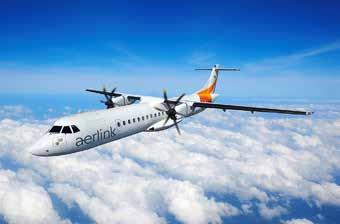
2 minute read
As jet charter use soars, Aerlink offers a responsible alternative
The Australian air charter market has a new entrant. The decision to establish Aerlink means an intentional step away from leaning on the reputation of Hevilift, founded on over 25 years of providing specialized heavy lift air capacity in some of the world’s most challenging environments. Hevilift continues its position of dominance in South-East Asia, but Aerlink sees the accomplished Australian team pivot to a dedicated ad hoc and contract charter focus.
Headquartered in Brisbane, Aerlink has well-resourced operations, crewing, in-house maintenance, and ground handling services. It is already poised for growth beyond its bases in Perth (PER), Brisbane (BNE), and Townsville (TSV). The airline is the only Australian operator of the Avions de Transport Regional (ATR) aircraft type, recognised as the world’s leading regional aircraft; a cost-effective and environmentally friendly plane fast finding favour with airlines worldwide. Aerlink operates six 68-passenger ATR72-500s, one 48-passenger ATR42-500, and two ATR42-300 freighters.
Advertisement
“Like us, our clients care about their people and are proactive in taking measures aimed at enhancing safety and decarbonization,” says Aerlink CEO Shane Cyr. “Our clients make a considered and responsible choice to fly with us. Our ATR 72s offer class-leading seated cabin space equal to that of an Airbus A320-200 and internal noise levels comparable to a regional jet. If transporting less than 86 passengers over a distance anywhere up to 500 nautical miles (926km), we cannot be beaten in terms of lowest fuel burn and related emissions”.
Aerlink’s long-term blue-chip client list includes industry leaders like Rio Tinto, Thiess, Covalent, Byrnecut Group, Ora Banda Gold and Chinova. The airline also regularly operates charter flights for the Australian Defence Force and Travel West, among other entities. Collaborating with Commercial Enterprise Queensland (CEQ) facilitates essential supplies to indigenous communities like Doomadgee and Kowanyama, especially during the sixmonth-long wet season.

Shorter travel distances amplify Aerlink’s emissions savings per journey. Over 300 nautical miles (555.6 kilometres), the ATR72 consumes 30% less fuel than rival turboprops and 45% less than regional jets (ATR, 2023). On an annual basis, choosing Aerlink over a competitor’s jet could prevent up to 4,400 tons of CO2 emissions, equivalent to operating 1000+ mine-spec 4x4 light vehicles (Dept of Climate Change, 2023).

While the fleet’s location can change subject to client demand, there are presently ATR72-500s based in Perth, Brisbane and Townsville. ATR42-300 Freighters are based in Brisbane and Cairns. Aerlink regularly fly into airports such as Broome (BME), Kalgoorlie (KGI), Mackay (MKY), Moranbah (MOV), Cairns (CNS), Doomadgee (DMD), and Pormpuraaw (EDR).
“Aerlink’s credibility is pivotal for attracting top-tier staff,” says Shane, President at Canada’s Universal Helicopters, before moving to Australia and taking up the CEO’s role. “They equip us to offer our clients full-service solutions with enhanced control, accountability, and notably quicker turnaround times. When our clients need us, we exist to take their challenge on as our own.”








